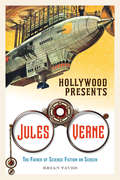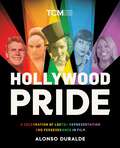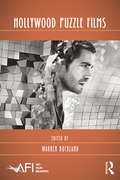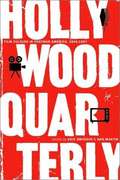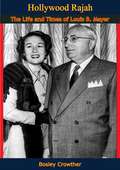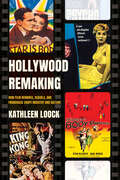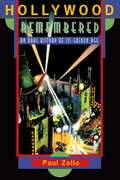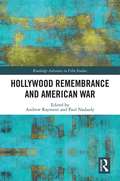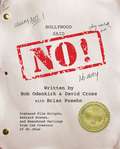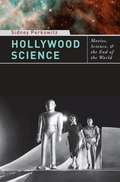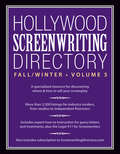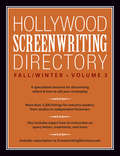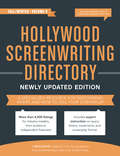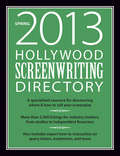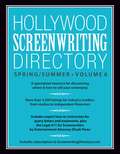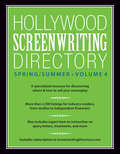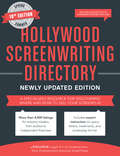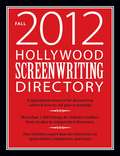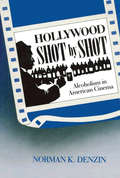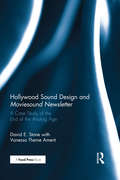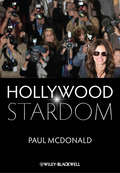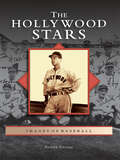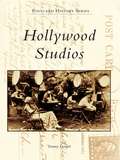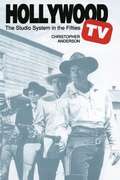- Table View
- List View
Hollywood Presents Jules Verne: The Father of Science Fiction on Screen (Screen Classics)
by Brian TavesAn &“illuminating&” look at how filmmakers have taken us around the world, under the sea, and to the center of the earth over the course of a century (Milwaukee Express). Even for those who have never read Jules Verne, the author&’s very name conjures visions of the submarine in Twenty Thousand Leagues Under the Sea, the epic race in Around the World in Eighty Days, the spacecraft in From the Earth to the Moon, and the daring descent in Journey to the Center of the Earth. One of the most widely translated authors of all time, Verne has inspired filmmakers since the early silent period and continues to fascinate audiences more than a century after his works were first published. His riveting plots and vivid descriptions easily transform into compelling scripts and dramatic visual compositions. In Hollywood Presents Jules Verne, Brian Taves investigates the indelible mark that the author has left on English-language cinema. Adaptations of Verne&’s tales have taken many forms—early movie shorts, serials, feature films, miniseries, and television shows—and have been produced as both animated and live-action films. Taves illuminates how, as these stories have been made and remade over the years, each new adaptation looks back not only to Verne&’s words but also to previous screen incarnations. He also examines how generations of actors have portrayed iconic characters such as Phileas Fogg and Captain Nemo, and how these figures are treated in pastiches such as Journey 2: The Mysterious Island. Investigating the biggest box-office hits as well as lower-budget productions, this comprehensive study will appeal not only to fans of the writer's work but also to readers interested in the ever-changing relationship between literature, theater, and film.
Hollywood Pride: A Celebration of LGBTQ+ Representation and Perseverance in Film
by Alonso DuraldeFor generations, members of the LGBTQ+ community in Hollywood needed to be discreet about their lives but—make no mistake—they were everywhere, both in front of and behind the camera. On the eve of the twentieth century, in Thomas Edison&’s laboratory, one of the earliest attempts at a sound film depicted two men dancing together as a third plays the violin. It&’s only a few minutes long, but this cornerstone of early cinema captured a queer moment on film. It would not be the last. With Hollywood Pride, renowned film critic Alonso Duralde presents a history spanning from the dawn of cinema through the &“pansy craze&” of the 1930s and the New Queer Cinema of the 1990s, all the way up to today. He showcases the hard-working actors, writers, directors, producers, cinematographers, art directors, and choreographers whose achievements defined the American film industry and charts the evolution of LGBTQ+ storytelling itself—the way mainstream Hollywood decided it would portray (or erase) their lives and the narratives created by queer filmmakers who fought to tell those stories themselves. Along the way, readers will encounter a fascinating cast of characters, such as the first generation of queer actors, including J. Warren Kerrigan, Ramon Novarro, and William Haines. Early cinema pioneers like Alla Nazimova and F. W. Murnau helped shape the new medium of moving pictures. The sex symbols, both male (Rock Hudson, Tab Hunter, and Anthony Perkins) and female (Lizabeth Scott and Greta Garbo), lived under the threat of their private lives undermining their public personas. Underground filmmakers Kenneth Anger and John Waters made huge strides in LGBTQ+ representation with their off-off-Hollywood productions in the 1960s and &’70s. These screen legends paved the way for every openly queer figure in Hollywood today. Illustrated with more than 175 full-color and black-and-white images, Hollywood Pride points to the bright future of LGBTQ+ representation in cinema by revealing the story of the community&’s inclusion and erasure, its visibility and invisibility, and its triumphs and tragedies.
Hollywood Puzzle Films (AFI Film Readers)
by Warren BucklandFrom Inception to The Lake House, moviegoers are increasingly flocking to narratologically complex puzzle films. These puzzle movies borrow techniques—like fragmented spatio-temporal reality, time loops, unstable characters with split identities or unreliable narrators—more commonly attributed to art cinema and independent films. The essays in Hollywood Puzzle Films examine the appropriation of puzzle film techniques by contemporary Hollywood dramas and blockbusters through questions of narrative, time, and altered realities. Analyzing movies like Source Code, The Butterfly Effect, Donnie Darko, Déjà Vu, and adaptations of Philip K. Dick, contributors explore the implications of Hollywood's new movie mind games.
Hollywood Quarterly: Film Culture in Post-war America, 1945-1957
by Eric Smoodin Ann MartinA collection of essays from the Hollywood Quarterly, the first long running film and media journal in the United States which was founded in 1947 by lefty Hollywood filmmakers and Southern California intellectuals.
Hollywood Rajah: The Life and Times of Louis B. Mayer
by Bosley CrowtherHE DISCOVERED GARBO AND GABLE.FOR NINE YEARS HE WAS THE HIGHEST SALARIED MAN IN THE U.S.HIS LIFE SURPASSED ALL HIS GREATEST FILMS IN LUXURY, NOTORIETY AND TRAGEDY.HE WAS A MAN TO BE FEARED.First published in 1960, Hollywood Rajah: The Life and Times of Louis B. Mayer is the explosive biography of the head of MGM studio; the fabulous behind-the-scenes story of the most powerful of Hollywood’s famed tycoons, it is a story more fantastic than any ever brought to the screen.This is the extravagant life story of Louis B. Mayer, once head of the largest motion picture studio in the world, and the most controversial subject in Hollywood’s notorious history—a man who went everywhere, did everything, and knew everyone worth knowing. A man whose tapeworm ego had to be fed by driving activity, ruthless use of power, and adventures with beautiful women. Louis B. Mayer was a power to be feared, a man who deliberately surrounded and protected himself with myths and legends.Now his true story can be told.
Hollywood Remaking: How Film Remakes, Sequels, and Franchises Shape Industry and Culture
by Kathleen LoockFrom the inception of cinema to today’s franchise era, remaking has always been a motor of ongoing film production. Hollywood Remaking challenges the categorical dismissal in film criticism of remakes, sequels, and franchises by probing what these formats really do when they revisit familiar stories. Kathleen Loock argues that movies from Hollywood’s large-scale system of remaking use serial repetition and variation to constantly negotiate past and present, explore stability and change, and actively shape how the film industry, cinema, and audiences imagine themselves. Far from a simple profit-making exercise, remaking is an inherently dynamic practice situated between the film industry’s economic logic and the cultural imagination. Although remaking developed as a business practice in the United States, this book shows that it also shapes cinematic aesthetics and cultural debates, fosters film-historical knowledge, and promotes feelings of generational belonging among audiences.
Hollywood Remembered: An Oral History of Its Golden Age
by Paul ZolloIn Hollywood Remembered, a wide array of Tinseltown veterans share their stories of life in the city of dreams from the days of silent pictures to the present. The 35 voices, many of whom have come to know Hollywood inside-out, range from film producers and movie stars to restaurateurs and preservationists. Actress Evelyn Keyes recalls how, fresh from Georgia, she met Cecil B. DeMille and was soon acting in Gone With the Wind; Blacklisted writer Walter Bernstein tells how he transformed his McCarthy era-experiences into drama with The Front; Steve Allen speaks out on how Hollywood has changed since he first came there in the 1920s; and Jonathan Winters relates how he left a mental institution to come work with Stanley Kramer in It's a Mad, Mad, Mad, Mad World.
Hollywood Remembrance and American War (Routledge Advances in Film Studies)
by Andrew Rayment and Paul NadasdyHollywood Remembrance and American War addresses the synergy between Hollywood war films and American forms of war remembrance. Subjecting the notion that war films ought to be considered ʻthe war memorials of today’ to critical scrutiny, the book develops a theoretical understanding of how Hollywood war films, as rhetorical sites of remembering and memory, reflect, replicate and resist American modes of remembrance. The authors first develop the framework for, and elaborate on, the co-evolution of Hollywood war cinema and American war memorialization in the historical, political and ideological terms of remembrance, and the parallel synergic relationship between the aesthetic and industrial status of Hollywood war cinema and the remembering of American war on film. The chapters then move to analysis of Hollywood war films – covering The Great War, World War II, The Korean War, The Vietnam War, The Cold War, and the wars in Afghanistan and Iraq – and critically scrutinize the terms upon which a film could be considered a memorial to the war it represents. Bringing together the fields of film studies and memory studies, this book will be of interest to scholars and students in not just these areas but those in the fields of history, media and cultural studies more broadly, too.
Hollywood Said No!: Orphaned Film Scripts, Bastard Scenes, and Abandoned Darlings from the Creators of Mr. Show
by David Cross Bob Odenkirk Brian PosehnBob Odenkirk and David Cross, creators of HBO's classic sketch comedy show Mr. Show, present to you this collection of never-before-seen scripts and ideas that Hollywood couldn't find the gumption to green-light. Simply put...HOLLYWOOD SAID NO!Since Mr. Show closed up shop, Bob and David have kept busy with many projects--acting in fun, successful, movies and TV shows, directing things, and complaining about stuff that didn't turn out well to anyone who would listen, and even alone, in silence, inside their own heads.HOLLYWOOD SAID NO! reveals the full-length, never-before-seen scripts for Bob and David Make a Movie (fleshed out with brand-new storyboards by acclaimed artist Mike Mitchell) and Hooray For America!: a satirical power-house indictment of all that you hold dear. This tome also includes a bonus section of orphaned sketch ideas from the Mr. Show days and beyond, suitable for performance by church groups that aren't all koo-koo about religion. What you are looking at online, and are about to buy, is chock-full of comic twists, turns, and maybe a few hard truths. We said "maybe," but what we mean was "probably not."Now, for the first time, take a peek at the scripts that didn't get the go-ahead and ponder a world we can only dream about...and beyond!
Hollywood Science: Movies, Science, and the End of the World
by Sidney PerkowitzWhether depicting humans battling aliens or a brave geologist saving lives as a volcano erupts, science-fiction films are an exciting visual and sensuous introduction to the workings of science and technology. These films explore a range of complex topics in vivid and accessible ways, from space travel and laser technology to genetic engineering, global warming, and the consequences of nuclear weaponry. Though actual scientific lab work might not be as exciting, science fiction is an engaging yet powerful way for a wide audience to explore some of the most pressing issues and ideas of our time. In this book, a scientist and dedicated film enthusiast discusses the portrayal of science in more than one hundred films, including science fiction, scientific biographies, and documentaries. Beginning with early films like Voyage to the Moon and Metropolis and concluding with more recent offerings like The Matrix, War of the Worlds, A Beautiful Mind, and An Inconvenient Truth, Sidney Perkowitz questions how much faith we can put into Hollywood's depiction of scientists and their work; how accurately these films capture scientific fact and theory; whether cataclysms like our collision with a comet can actually happen; and to what extent these films influence public opinion about science and the future. Movies, especially science-fiction films, temporarily remove viewers from the world as they know it and show them the world as it might be, providing special perspective on human nature and society. Yet "Hollywood science" can be erroneous, distorting fact for dramatic effect and stereotyping scientists as remote and nerdy, evil, or noble, doing little to improve the relationship between science and society. Bringing together history, scientific theory, and humorous observation, Hollywood Science features dozens of film stills and a list of the all-time best and worst science-fiction movies. Just as this genre appeals to all types of viewers, this book will resonate with anyone who has been inspired by science-fiction films and would like to learn how fantasy compares to fact.
Hollywood Science: Movies, Science, and the End of the World (Acs Symposium Ser. #1139)
by Sidney PerkowitzWhether depicting humans battling aliens or a brave geologist saving lives as a volcano erupts, science-fiction films are an exciting visual and sensuous introduction to the workings of science and technology. These films explore a range of complex topics in vivid and accessible ways, from space travel and laser technology to genetic engineering, global warming, and the consequences of nuclear weaponry. Though actual scientific lab work might not be as exciting, science fiction is an engaging yet powerful way for a wide audience to explore some of the most pressing issues and ideas of our time.In this book, a scientist and dedicated film enthusiast discusses the portrayal of science in more than one hundred films, including science fiction, scientific biographies, and documentaries. Beginning with early films like Voyage to the Moon and Metropolis and concluding with more recent offerings like The Matrix, War of the Worlds, A Beautiful Mind, and An Inconvenient Truth, Sidney Perkowitz questions how much faith we can put into Hollywood's depiction of scientists and their work; how accurately these films capture scientific fact and theory; whether cataclysms like our collision with a comet can actually happen; and to what extent these films influence public opinion about science and the future. Movies, especially science-fiction films, temporarily remove viewers from the world as they know it and show them the world as it might be, providing special perspective on human nature and society. Yet "Hollywood science" can be erroneous, distorting fact for dramatic effect and stereotyping scientists as remote and nerdy, evil, or noble, doing little to improve the relationship between science and society. Bringing together history, scientific theory, and humorous observation, Hollywood Science features dozens of film stills and a list of the all-time best and worst science-fiction movies. Just as this genre appeals to all types of viewers, this book will resonate with anyone who has been inspired by science-fiction films and would like to learn how fantasy compares to fact.
Hollywood Screenwriting Directory Fall/Winter Volume 3
by Jesse DoumaScreenwriting market intel you won't find anywhere else! Mailing out submissions based on some contact information you found on the Internet isn't going to get your script sold. What's truly valuable to an aspiring screenwriter is the kind of specific details you can only get through years of Industry experience. That's why The Writers Store compiled the Hollywood Screenwriting Directory, the product of more than three decades working directly with the people behind the world's favorite films. This targeted reference book features: Verified contact information for Hollywood buyers, including phone numbers, and street and email addresses. Crucial details like whether they accept unsolicited material and how they prefer to receive submissions. A guide to proper script format and advice on packaging your submission. Step-by-step instructions for writing professional query letters, treatments and tag lines. Plus, you'll find samples throughout, illustrated with tips and pointers to help you create a quality submission. With the Hollywood Screenwriting Directory by your side, you'll have a reliable resource that significantly ups your chances of script-selling success!
Hollywood Screenwriting Directory Fall/Winter Volume 3: A Specialized Resource for Discovering Where & How to Sell Your Screenplay
by Jesse DoumaScreenwriting market intel you won't find anywhere else! Mailing out submissions based on some contact information you found on the Internet isn't going to get your script sold. What's truly valuable to an aspiring screenwriter is the kind of specific details you can only get through years of Industry experience. That's why The Writers Store compiled the Hollywood Screenwriting Directory, the product of more than three decades working directly with the people behind the world's favorite films. This targeted reference book features: Verified contact information for Hollywood buyers, including phone numbers, and street and email addresses. Crucial details like whether they accept unsolicited material and how they prefer to receive submissions. A guide to proper script format and advice on packaging your submission. Step-by-step instructions for writing professional query letters, treatments and tag lines. Plus, you'll find samples throughout, illustrated with tips and pointers to help you create a quality submission. With the Hollywood Screenwriting Directory by your side, you'll have a reliable resource that significantly ups your chances of script-selling success!
Hollywood Screenwriting Directory Fall/Winter: A Specialized Resource for Discovering Where & How to Sell Your Screenplay
by Jesse Douma Dinah PerezTo get your screenplay in front of the right buyer, you need exclusive information and specific details you can only gain through years of industry experience. That's why The Writers Store has compiled the Hollywood Screenwriting Directory, the product of more than three decades working directly with the decision makers behind the world's favorite films. This invaluable reference features:Thousands of listings for Hollywood buyers, industry insiders, studios, and independent financiers, all with verifi ed contact informationCrucial details for submitting your screenplay to specific markets: how they prefer to receive submissions, and whether they accept unsolicited materialA guide to properly formatting your script and packaging your submissionClear, step-by-step instructions for crafting professional query letters, treatments, and log linesA Silver subscription to ScreenwritingDirectory.com (a $49 value)In addition, you'll find illustrated screenplay samples, essential legal information, and tips for creating a quality submission. With the Hollywood Screenwriting Directory at your fingertips, you'll significantly increase your chances of script-selling success!
Hollywood Screenwriting Directory Spring 2013
by Jesse DoumaScreenwriting market intel you won't find anywhere else! Mailing out submissions based on some contact information you found on the Internet isn't going to get your script sold. What's truly valuable to an aspiring screenwriter is the kind of specific details you can only get through years of Industry experience. That's why The Writers Store compiled the Hollywood Screenwriting Directory, the product of more than three decades working directly with the people behind the world's favorite films. This targeted reference book features: Verified contact information for Hollywood buyers, including phone numbers, and street and email addresses. Crucial details like whether they accept unsolicited material and how they prefer to receive submissions. A guide to proper script format and advice on packaging your submission. Step-by-step instructions for writing professional query letters, treatments and tag lines. Plus, you'll find samples throughout, illustrated with tips and pointers to help you create a quality submission. With the Hollywood Screenwriting Directory by your side, you'll have a reliable resource that significantly ups your chances of script-selling success!
Hollywood Screenwriting Directory Spring/Summer Volume 4
by Writer's Store EditorsThe Hollywood Screenwriting Directory is a specialized resource for discovering where and how to sell your screenplay. It contains over 2,500 listings for Industry insiders such as studios, production companies, and independent financiers - plus, pointers to help you create a quality screenplay submission. The Hollywood Screenwriting Directory includes a free subscription to ScreenwritingDirectory.com, where screenwriters can access updated listings and market their projects to Industry Professionals.
Hollywood Screenwriting Directory Spring/Summer Volume 4: A Specialized Resource for Discovering Where & How to Sell Your Screenplay
by Writer's Store EditorsThe Hollywood Screenwriting Directory is a specialized resource for discovering where and how to sell your screenplay. It contains over 2,500 listings for Industry insiders such as studios, production companies, and independent financiers - plus, pointers to help you create a quality screenplay submission. The Hollywood Screenwriting Directory includes a free subscription to ScreenwritingDirectory.com, where screenwriters can access updated listings and market their projects to Industry Professionals.
Hollywood Screenwriting Directory Spring/Summer: A Specialized Resource for Discovering Where & How to Sell Your Screenplay
by Jesse Douma Dinah PerezReady to submit your screenplay but not sure about the logistics? With over 4,000 listings for Industry insiders such as studios, production companies, and independent financiers, this handy directory gives you the scoop on query letters, treatments and much more. Plus, the Legal 411 for Screenwriters section by entertainment attorney Dinah Perez is well worth the cost of the book. Get a head start with:Correct addresses and info for buyers (more than 4,000 listings!)The top ways to write and format loglines, treatments and query lettersInside screenwriting intelThe legalities of screenwriting and more from Dinah Perez!Up-to-Date It's true that contact information in Hollywood can change in the blink of an eye. You'll benefit from the updates to more than 50 percent of last year's listings. Also new are Facebook profiles, email addresses and more.What Matters to You Tons of information is included because so many things go into a successful submission. Browse information such as:Verified contact details, so you can email, phone or stop by in personPackaging your submission for best resultsScript formatWho receives unsolicited workThe legalities that go into each stage of the screenwriting and production processHow each financier, production company or studio wants submissions
Hollywood Screenwriting Directory: A Specialized Resource for Discovering Where & How to Sell Your Screenplay
by The Writers Storedirectory
Hollywood Shot by Shot: Alcoholism in American Cinema (Communication And Social Order Ser.)
by Norman K. DenzinTo what extent have Hollywood feature films shaped the meanings that Americans attach to alcoholics, their families, and the alcoholic condition? To what extent has the mass culture of the movie industry itself been conceptually shaped by a broad, external societal discourse? Norman Denzin brings to his life-long study of alcoholism a searching interest in how cultural texts signify and lend themselves to interpretation within a social nexus. Both historical and diachronic in his approach, Denzin identifies five periods in the alcoholism films made between 1932 and the end of the 1980s, and offers a detailed critical reading of thirty-seven films produced during these six decades.
Hollywood Sound Design and Moviesound Newsletter: A Case Study of the End of the Analog Age
by David StoneAs film students and younger fans experience "Big Hollywood Sound" in Imax presentations and digital theaters, many are also discovering action and adventure movies made well before they were born. There is a legacy to be enjoyed in the sound of these films: Blockbuster movies of the ‘80’s, and ‘90’s are notable for the extraordinarily dramatic impact of their sound mixing, and the way in which it could immerse audiences in a surrounding space. During this period, a small group of sound professionals in Hollywood wrote and published a critical journal about the craftsmanship, new technology, and changing aesthetics that excited conversation in their community. Their work has been edited and compiled here for the first time. David Stone is a sound editor, a veteran of roughly 100 Hollywood feature films, such as Gremlins, Top Gun, Die Hard, Speed, and Ocean’s 11. He was a Supervising Sound Editor for projects as varied as Predator, Edward Scissorhands, Beauty and the Beast, Batman Returns, City Slickers 2, and Dolores Claiborne. He has collected Golden Reel awards for Best Sound Editing five times, and won the 1992 Academy Award® for best Sound Effects Editing, for his supervising work on Bram Stoker’s Dracula. In 2015, he received a Lifetime Achievement Award from the San Luis Obispo Jewish Film Festival in California. Stone is now a Professor and former Chair of Sound Design at Savannah College of Art and Design. Between 1989 and 1994, he was the editor of Moviesound Newsletter, which was published by Vanessa Ament. Dr. Vanessa Theme Ament is the author of The Foley Grail, and a contributor to Sound: Dialogue, Music, and Effects (the Silver Screen Series). She is on the steering committee for Cinesonika, an international film festival and conference. A veteran Foley artist, sound editor, and voice actor from Los Angeles, she also writes and sings jazz, and is a member of the American Federation of Musicians, SAG-AFTRA, Actors Equity, and the Editors Guild. She worked on Die Hard, sex, lies, and videotape, Platoon, Predator, Edward Scissorhands, Beauty and the Beast, Noises Off, and A Goofy Movie, and many other films. Dr. Ament received her Ph.D. in Communication, in the area of Moving Image Studies, from Georgia State University in Atlanta, and is presently the Edmund F. and Virginia B. Ball Endowed Chair Professor of Telecommunications, at Ball State University in Muncie, Indiana.
Hollywood Stardom
by Paul McdonaldBy integrating star studies and film industry studies, Hollywood Stardom reveals the inextricable bonds between culture and commerce in contemporary notions of film stardom.Integrates the traditions of star studies and industry studies to establish an original and innovative mode of analysis whereby the 'star image' is replaced with the 'star brand'Offers the first extensive analysis of stardom in the 'post-studio' eraCombines genre, narrative, acting, and discourse analysis with aspects of marketing theory and the economic analysis of the film marketDraws on an extensive body of research data not previously deployed in film scholarshipA wide range of star examples are explored including George Clooney, Mel Gibson, Tom Cruise, Daniel Day-Lewis, Tom Hanks, Will Smith, and Julia Roberts
Hollywood Stars, The (Images of Baseball)
by Richard BeverageThe Hollywood Stars were created in 1926, when the Salt Lake City franchise of the Pacific Coast League was transferred to the greater Los Angeles area. To avoid confusion with the resident Los Angeles Angels, the new ballclub was called Hollywood. It was a wise choice of names. The movie capital had a glamour that was soon attached to the Stars and created an interest wherever they played. But the Hollywood story is actually one of two separate entities. The first operated from 1926 to 1935 and played at Wrigley Field as a tenant of the Angels. When a dispute arose in 1935 over a proposed increase in rent, owner Bill Lane moved his team to San Diego. After a hiatus of two years, the second incarnation was created in 1938 when the Mission Reds of San Francisco moved to Southern California. They moved into their new park, Gilmore Field, in 1939 and remained there through 1957, when the Dodgers moved to Los Angeles. Hollywood won pennants in 1949, 1952, and 1953 and was the team of choice for the movie world.
Hollywood Studios (Postcard History Series)
by Tommy DangcilJust after the turn of the 20th century, the motion picture industry moved to the West Coast, and the largest land of make-believe was created in Hollywood, California. From the silent-era beginnings of primitive, open-air stages to the fabled back lots of the studios' heyday, Hollywood Studios presents a bygone era of magical moviemaking in rare postcards. Assembled from the author's private collection, these images from the Chaplin Studios to Metro-Goldwyn Mayer depict an insider's look back at the dream factories known as the Hollywood studios.
Hollywood TV: The Studio System in the Fifties
by Christopher AndersonThe 1950s was one of the most turbulent periods in the history of motion pictures and television. During the decade, as Hollywood's most powerful studios and independent producers shifted into TV production, TV replaced film as America's principal postwar culture industry. This pioneering study offers the first thorough exploration of the movie industry's shaping role in the development of television and its narrative forms. Drawing on the archives of Warner Bros. and David O. Selznick Productions and on interviews with participants in both industries, Christopher Anderson demonstrates how the episodic telefilm series, a clear descendant of the feature film, became and has remained the dominant narrative form in prime-time TV. This research suggests that the postwar motion picture industry was less an empire on the verge of ruin-as common wisdom has it-than one struggling under unsettling conditions to redefine its frontiers. Beyond the obvious contribution to film and television studies, these findings add an important chapter to the study of American popular culture of the postwar period.
